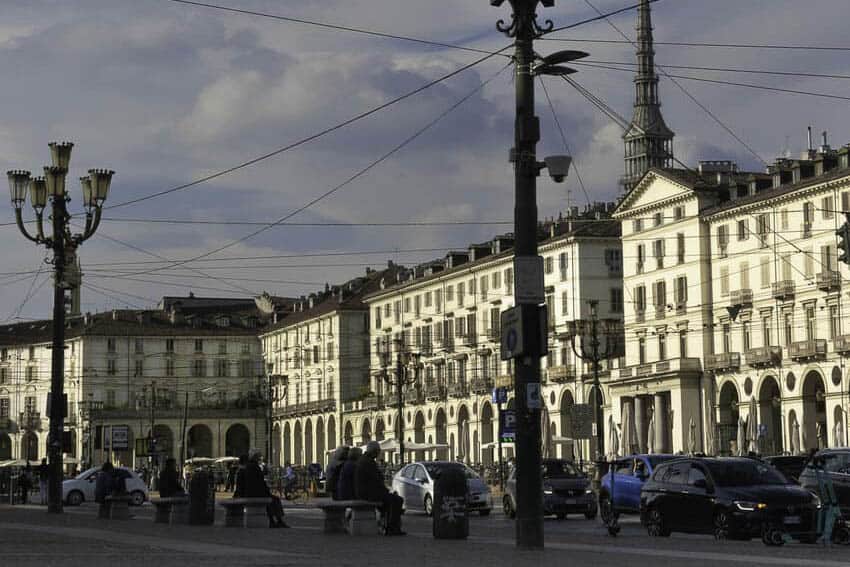A Culinary Journey through Friuli–Venezia Giulia
By Elisabeth Antoine Crawford
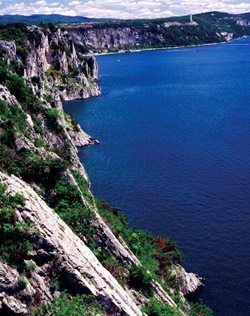
Tucked away between mountains and sea in Italy’s northeast corner, Friuli–Venezia Giulia boasts one of the country’s most distinctive regional cuisines.
Practically undiscovered by tourists, the region offers a wealth of culinary riches, from plum-filled gnocchi to Hungarian-style goulash, from fried cheese and potato pancakes to the dried fruit and nut spiral cake called gubana.
Trieste’s Austro-Hungarian Influence
We’ll begin our journey in the region’s capital, Trieste, a cosmopolitan city that was ruled by the Hapsburg Empire for over five hundred years.
The Austro-Hungarian influence is evident in all areas of the city’s culture, from the stately architecture in Piazza dell’Unità d’Italia to the goulash, liptauer cheese, and sauerkraut served in the typical buffet (a small eatery where you can grab a quick snack or light meal).
Many varieties of dumplings may be found throughout the region; two popular versions in Trieste are the savory gnocchi di pane (bread dumplings) and the dessert-like gnocchi di susine (potato dumplings filled with plums and tossed with browned butter, breadcrumbs, sugar, and cinnamon).
In Trieste’s elegant bakeries, Viennese desserts such as sachertorte, dobostorte, and apple strudel line the shelves alongside the Slovenian-inspired, spiral-shaped pastries presnitz and putizza.
Seafood from the Adriatic
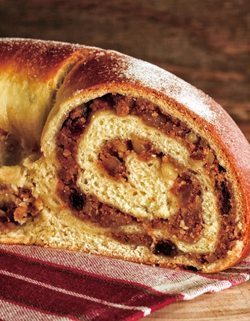
The Adriatic Coast extends from the craggy cliffs of the Carso—the rocky plateau that comprises the province of Trieste—eastward to the marshy lagoons around the towns of Grado and Marano Lagunare.
Seafood is plentiful, and species that are exclusive to the northeast Atlantic and Mediterranean, such as sardoni barcolani (European anchovies), scampi (langoustines), and granzievola (European spider crab), are especially prevalent at the dinner table.
In addition, the Adriatic provides a seemingly endless supply of squid, octopus, mantis shrimp, scallops, mussels, and clams.
Wine Country
The landscape of central Friuli consists of rolling hills and fertile plains, and the region’s best-known wine zones are located here.
The Collio zone, centered on the town of Cormòns in the province of Gorizia, is famous for its white wines, Tocai Friulano in particular. The zone’s most notable white wine blend is the Vino della Pace, products from 540 grape varieties from every continent; this “wine of peace” is distributed to political and religious leaders around the world. To the north of the Collio lies the Colli Orientali zone, home of Picolit—one of the rarest and most precious dessert wines ever made.
Venetian Influence in Central Friuli
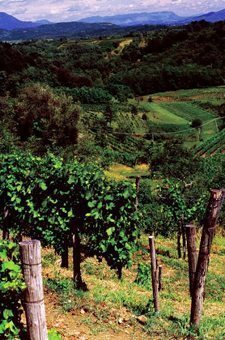
After Trieste, Udine and Pordenone are the region’s largest urban centers. Throughout these cities and the surrounding villages, the influence is clearly Venetian.
While Trieste had astutely turned to the Hapsburgs of Austria for protection in the late 14th century, Udine and Pordenone were soon conquered by the power-hungry Venetian Republic.
Replicas of Venetian landmarks such as the winged lion of Saint Mark, the blue-and-gold clock tower, and the pink-striped Palazzo Ducale were built in Udine’s Piazza della Libertà, while the characteristic trilobed Venetian Gothic arches appear on palazzi throughout central Friuli.
Venetian dishes such as baccalà mantecato (salt cod purée), sarde in saor (marinated sardines), and countless varieties of risotto are prominent on every menu.
Across the flat plains of central Friuli, endless fields of corn line the highways. First introduced to the Venetian Republic by the Spaniards and later reintroduced by the Turks, corn has been a dietary staple for centuries. Made from ground cornmeal, the region’s ubiquitous side dish, polenta, is often served at every meal.
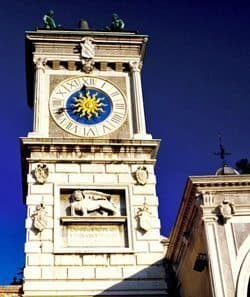
In general, many of Friuli’s crops could be considered foods of poverty. It is no coincidence that these foods—potatoes, for example—have a long shelf life, an important factor in a region where the winters are often brutally cold.
Some foods like beans and barley can be dried, while others such as turnips and cabbage are preserved through fermentation—all may then turn up in soups and stews year-round.
Prosciutto of San Daniele
Traveling through Friuli’s plains, an occasional hill town may be seen rising from the monotonous countryside. The most familiar would have to be San Daniele, known worldwide for its prosciutto di San Daniele.
The Celts were the first culture to use salt in preserving pork, and their arrival around 400 BC on the hill now known as San Daniele marks the origin of this celebrated ham. The town’s dry climate and fresh breezes are said to make the perfect environment for curing prosciutto.
Slovenian-Inspired Pastries
Bordered on one side by Slovenia, Friuli has integrated many Slavic dishes into its repertoire, the best example being gubana, a dessert that hails from the town of Cividale. Derived from the Slovene word guba, meaning “wrinkle” or “fold,” its name is suggestive of the swirls and spirals in this sumptuous pastry. Filled with a mixture of dried fruit, nuts, and spices, gubana may be prepared with either a yeast-based dough or puff pastry.
Northern Mountains of Carnia
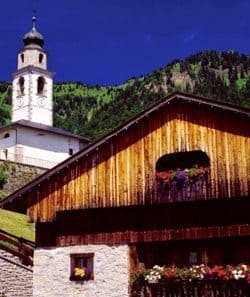
To the north along the Austrian border, the mountains of Friuli may be divided into the Carnian Alps (Carnia) in the west and the Giulian Alps to the east. Here, onion-domed church steeples, gabled chalets, and Alpine farmhouses dot the landscape, while aromas of smoked pork and goulasch waft onto village streets at mealtime.
Long isolated from the rest of the region by a harsh climate and rugged terrain, the people of this area had to become self-sufficient, making use of wild mushrooms, herbs, fruits, and berries that could be gathered in their fields and forests.
Friuli’s Cheeses
At one time, the economy of Carnia depended almost exclusively on the breeding of cattle, and today cows are still raised primarily for milk. Montasio cheese is one of Friuli’s chief products and is the star of Friuli’s signature dish, frico, of which there are two main types.
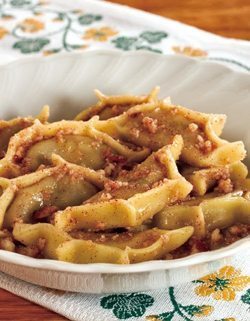
Frico croccante (crispy frico) is made by frying a handful of aged Montasio; when golden-brown, the pancake can be inverted onto a bowl to harden and then filled with such treats as polenta, mushrooms, or wild greens.
Frico con patate is a potato and cheese pancake, prepared with a combination of aged and fresh Montasio—crispy on the outside and oozing with melted cheese and mashed potato goodness on the inside.
Another classic cheese of Friuli is ricotta affumicata (smoked ricotta). It originated when dairy farmers once produced more ricotta than their families could consume.
They soon discovered that curing the cheese over the hood of a fogolâr (fireplace) was an excellent method of preservation—and it gave the cheese a distinctive smoky flavor. Ricotta affumicata is Carnia’s traditional topping for gnocchi and pasta.
Integrating Exotic Spices
From the port of Trieste to the mountain passages crossing the Alps, the path of the ancient spice trade ran directly through Friuli. This fortuitous bit of history has left a considerable impact on the region’s cuisine. Caraway seeds, paprika, and poppy seeds from central Europe and spices from the Far East such as cinnamon, nutmeg, and cloves have all found their way into countless traditional recipes.
One of the most distinctive is cjarsòns, a type of stuffed pasta from Carnia with a multitude of possible fillings. While there are generally two varieties—sweet and savory—the flavors often tend to overlap. The sweet cjarsòns may be filled with apples, pears, dried fruit, nuts, chocolate, and spices, but often contain savory herbs such as parsley or basil.
Likewise, the s avory cjarsòns have undertones of sweetness, combining such unlikely ingredients as potatoes, raisins, onions, cocoa, jam, and spinach. Both sweet and savory cjarsòns are served in melted butter and are typically topped with ricotta affumicata and a sprinkle of sugar and cinnamon.
avory cjarsòns have undertones of sweetness, combining such unlikely ingredients as potatoes, raisins, onions, cocoa, jam, and spinach. Both sweet and savory cjarsòns are served in melted butter and are typically topped with ricotta affumicata and a sprinkle of sugar and cinnamon.
A veritable melting pot of cultures, Friuli–Venezia Giulia reveals its diverse heritage with every bite. As the Friulian people cleverly merge humble, local ingredients with exotic spices from foreign lands, the result is a cuisine that, while often surprising in its blend of sweet and savory flavors, never ceases to delight the palate.
Where to Eat
Buffet Da Pepi
Via della Cassa di Risparmio, 3
Trieste
39/040-366858
http://www.buffetdapepi.com/
Trieste’s oldest buffet. Order the piatto misto, a platter of assorted pork that comes with a side of sauerkraut.
Trattoria Al Cacciatore de La Subida
Località Monte, 22
Cormòns
39/0481-60531
http://www.lasubida.it/
Possibly the best restaurant in all of Friuli, specializing in traditional dishes inspired by the owner’s Slavic roots.
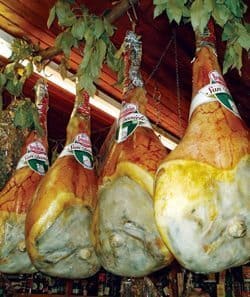
Enoteca di Cormòns
Piazza XXIV Maggio, 21
Cormòns
39/0481-630371
http://www.enoteca-cormons.it/
A relaxing spot to taste local wines, cheese, and prosciutto. Also the home of the Collio’s wine-producing consortium.
Osteria Al Vecchio Stallo
Via Viola, 7
Udine
39/0432-21296
Serves hearty, rustic fare in a renovated 400-year-old horse stable. Don’t miss their mouthwatering version of frico.
Ristorante Salon
Via Peresson, 70
Piano d’Arta (Arta Terme)
39/0433-92003
http://www.albergosalon.com/
Located near the Terme di Arta thermal baths, serving fantastic cjarsòns filled with fruit, spices, and fresh herbs.
Pasticceria Penso
Via A. Diaz, 11
Trieste
39/040-301530
http://www.pasticceriapenso.com/
One of Trieste’s oldest bakeries, offering 35 different types of pastries, cakes, and cookies. Their sachertorte, a local favorite, is kept exceptionally moist by a dousing of Maraschino liqueur.

Buy the author’s cookbook, Flavors of Friuli: A Culinary Journey through Northeastern Italy on Amazon.
Elisabeth Antoine Crawford lives in San Francisco and is the author of the award-winning cookbook Flavors of Friuli: A Culinary Journey through Northeastern Italy. Visit her culinary travel website.
Eurail Passes: What to Know about Buying a Europe Train Pass
- These 9 U.S. National Parks Require Reservations in 2024 - April 17, 2024
- Take a Hike in Olympic National Park - April 17, 2024
- The Wild Mississippi: 2340 Miles Across Ten States - April 8, 2024




